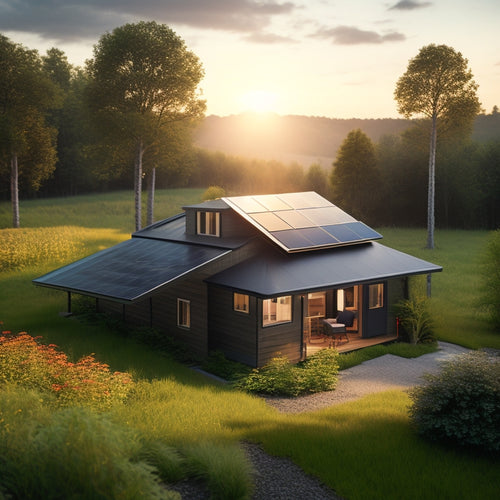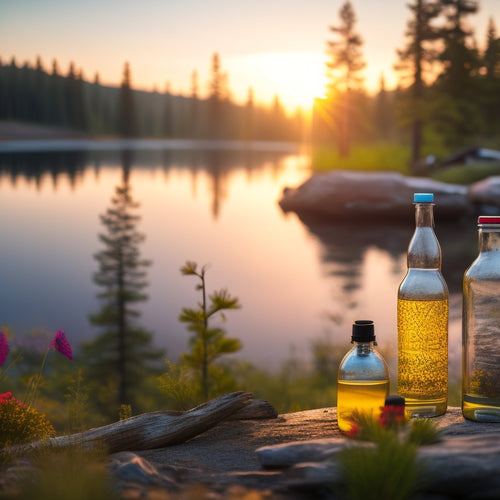
3 Simple Ways to Clean Your Panels
Share
You can greatly reduce the time and effort spent on cleaning your solar panels by selecting the right coatings and understanding effective cleaning methods. For instance, opt for dust-repelling coatings that decrease dust accumulation, making cleaning easier and less frequent. Use natural cleaning methods like water and a soft-bristled brush or a vinegar solution to remove dirt and grime. Additionally, consider nano-structured coatings that enhance hydrophobicity, reducing maintenance needs. By understanding these simple ways to clean your panels, you'll be well on your way to maximizing their performance and energy efficiency - and there's more to investigate to optimize your solar panel investment.
At a Glance
- Use water and a soft-bristled brush to effectively remove dirt and grime from solar panels.
- Mix vinegar with water to create a solution that loosens dirt and grime on panels.
- Apply a baking soda paste as a natural abrasive to remove tougher grime and debris.
- Regular inspections for dirt buildup help maintain panel performance and efficiency.
- Daily cleaning can significantly reduce water spot formation and maintain optimal energy production.
Dust-Repelling Coatings Save Time
You'll find that dust-repelling coatings can greatly reduce the attraction of dust to your panels, making cleaning a much faster process.
With these coatings, you're guaranteed an easy cleaning experience, as they prevent dust from accumulating in the first place. By applying these coatings, you'll save time and effort in the long run, ensuring your panels remain in top condition.
Additionally, when combined with a reliable Solar Energy Storage solution, you can maximize your energy output and reduce your reliance on the grid. This will also enable you to store excess energy generated during the day for use during the night or on cloudy days.
Coatings Reduce Dust Attraction
Coatings play an essential role in reducing dust attraction on solar panels, and their benefits are undeniable. By applying a dust-repelling coating, you can greatly decrease the amount of dust that settles on your panels. This is especially important, as dust attraction can lead to a considerable decrease in energy output.
In fact, having a reliable energy storage system, such as a home battery storage solution, can help maximize your solar panel investment by storing excess energy generated during the day for use during off-peak hours. By combining clean solar panels with efficient energy storage, you can optimize your energy consumption and reduce your reliance on the grid.
Surface treatments, such as hydrophobic and hydrophilic coatings, can be applied to reduce dust attraction. These coatings work by creating a surface that water can easily roll off of, taking dirt and dust particles with it. This means you'll spend less time cleaning your panels, and more time enjoying the freedom that comes with generating your own clean energy.
When choosing a coating, consider the type of environment your panels will be in. For example, if your panels will be exposed to high levels of humidity, a hydrophilic coating may be the best choice.
Easy Cleaning Guaranteed
By reducing dust attraction, you're already saving time and effort on maintenance. Dust-repelling coatings make cleaning a breeze, allowing you to focus on more important things. With these coatings, you'll experience:
| Coating Type | Dust Attraction | Cleaning Frequency |
|---|---|---|
| Standard | High | Weekly |
| Hydrophobic | Medium | Bi-Weekly |
| Oleophobic | Low | Monthly |
| Nano-Coated | Very Low | Quarterly |
| Self-Cleaning | Negligible | Rarely |
Reduces Water Spotting Risk
When you clean your panels regularly, you'll greatly reduce the risk of water spotting.
By incorporating spot prevention methods into your daily cleaning routine, you'll prevent mineral deposits from forming and guarantee your panels remain efficient, just like a well-maintained residential solar power system that generates peak renewable energy.
This is especially important for homeowners who've invested in photovoltaic cells for their eco-friendly homes.
With the right techniques, you can minimize the occurrence of water spots and maintain your panels' performance.
Spot Prevention Methods
Since water spots can cause significant damage to your panels, it is essential to adopt effective spot prevention methods to minimize the risk of water spotting. By taking proactive measures, you can guarantee your panels remain in good condition and maintain their efficiency.
One way to prevent water spots is by applying stain resistant materials or surface treatments to your panels. These coatings create a hydrophobic surface, causing water to bead up and roll off, reducing the likelihood of water spots forming.
Here is a summary of popular spot prevention methods:
| Method | Description | Effectiveness |
|---|---|---|
| Ceramic coating | Creates a hydrophobic surface | High |
| Silane-based coating | Repels water and reduces surface tension | Medium |
| Wax-based coating | Provides temporary protection | Low |
| Nano-coating | Creates an extremely hydrophobic surface | Very High |
Daily Cleaning Routine
Implementing a daily cleaning routine is crucial in reducing the risk of water spotting on your solar panels. By doing so, you'll guarantee peak energy production and prolong the lifespan of your panels.
Aim to clean your panels at least once a day, ideally during the early morning or late afternoon when the sun isn't directly overhead.
In your daily routine, use a soft-bristled brush or a microfiber cloth to gently sweep away loose debris. This will prevent dirt and dust from accumulating and causing water spots.
For more thorough cleaning, use a mixture of mild soap and distilled water. Avoid using harsh chemicals or abrasive materials that can scratch the panels.
Regular cleaning frequency is key to preventing water spots. As part of your maintenance tips, inspect your panels regularly for signs of dirt buildup or water spotting.
Nano-Structure Boosts Hydrophobicity
When you apply a nano-structure to your panels, you're giving them a hydrophobic enhancement that enhances their water repellent properties, similar to those found in solar power solutions that maximize energy output.
By incorporating this technology, homeowners can reduce their reliance on traditional energy sources and minimize their carbon footprint.
This means water will bead up and roll off more easily, reducing the risk of water spots and mineral deposits.
As a result, your panels will develop enhanced self-cleaning abilities, making maintenance a whole lot easier.
Water Repellent Properties
By incorporating a nano-structured surface, your solar panels can exhibit enhanced water repellent properties, which is essential for maintaining ideal energy output.
This unique surface feature allows water to roll off easily, reducing the risk of water spots and mineral deposits that can compromise your panel's performance.
The hydrophobic properties of a nano-structured surface also contribute to improved water resistance.
This means that your panels will be better equipped to withstand exposure to moisture, reducing the likelihood of corrosion and damage.
As a result, you can expect a longer surface longevity, which translates to a longer lifespan for your solar panels.
Enhanced Self-Cleaning Abilities
Across the surface of your solar panels, a nano-structured layer can considerably enhance hydrophobicity, leading to improved self-cleaning abilities. This state-of-the-art technology enables water to roll off the panel's surface more easily, taking dirt and debris with it. As a result, you'll notice a significant reduction in the frequency of panel maintenance.
By incorporating self-cleaning technology into your solar panels, you'll benefit from increased energy output and reduced costs associated with manual cleaning. The nano-structured layer works in tandem with natural rainfall, allowing the panels to clean themselves without the need for additional resources.
This innovative approach to panel maintenance not only saves you time but also minimizes the risk of damage caused by manual cleaning methods.
With enhanced self-cleaning abilities, you can rest assured that your solar panels are operating at peak performance, providing you with the freedom to generate clean energy without the hassle of frequent maintenance.
Check Warranty and Durability
You should always check your solar panel warranty expiration dates to confirm you're still covered in case of defects or malfunctions.
When designing a home energy management system, it's crucial to take into account renewable energy systems that integrate seamlessly with your solar panels.
Additionally, you'll want to review the panel durability ratings, which indicate the panels' resistance to environmental stressors and cleaning methods.
Warranty Expiration Dates
When purchasing solar panels, it's vital to understand the warranty expiration dates, as they greatly impact the durability and performance of your system. You need to be aware of the warranty coverage and maintenance guidelines to guarantee you're getting the most out of your investment.
Typically, solar panel manufacturers provide a 25-year warranty on their products, but it's important to check the specific terms and conditions.
Check your warranty documents to see what's covered and for how long. Some warranties may only cover certain components, like the panels themselves, while others may include inverters, mounts, and other equipment.
Understanding the warranty expiration dates will help you plan for future maintenance and potential repairs. Additionally, following the recommended maintenance guidelines will help extend the life of your system and guarantee peak performance.
Panel Durability Ratings
Manufacturer warranty expiration dates serve as a safeguard, but they're only half the story. You also need to evaluate the durability rating of your panels to guarantee peak panel performance. This rating measures the panels' resistance to environmental factors like humidity, temperature, and UV exposure.
| Durability Rating | Description |
|---|---|
| Tier 1 | Meets minimum industry standards for durability |
| Tier 2 | Exceeds industry standards, suitable for moderate climates |
| Tier 3 | High-performance panels, ideal for harsh environments |
| Tier 4 | Premium panels with enhanced durability features |
| Tier 5 | Top-of-the-line panels, designed for extreme conditions |
When choosing panels, look for those with higher durability ratings. This guarantees your panels will withstand the elements and maintain their performance over time. Regular maintenance tips, such as cleaning your panels, can also help extend their lifespan. By evaluating both warranty expiration dates and durability ratings, you'll be well on your way to maximizing your panel's performance and enjoying the freedom that comes with reliable energy independence.
Less Chemicals Needed
You'll be surprised to find that your solar panels don't need harsh chemicals to stay clean.
In fact, natural cleaning methods are often more effective and gentler on the panels. By using water and a soft-bristled brush, you can remove dirt and grime without compromising the integrity of your system.
Natural Cleaning Methods
Most solar panels accumulate a substantial amount of dirt and debris over time, greatly reducing their efficiency.
But you don't need harsh chemicals to get the job done. Natural cleaning methods are a great alternative, and they're better for the environment too.
You can start by mixing a vinegar solution with water in a spray bottle. Spray the solution onto the panels, letting it sit for about 10 minutes to loosen the dirt.
Then, use a soft-bristled brush or a microfiber cloth to wipe down the panels. Rinse with clean water, and you're good to go.
For tougher grime, try using baking soda as a natural abrasive. Mix baking soda with water to form a paste, and apply it to the panels using a soft-bristled brush.
Let it sit for about an hour, then rinse with clean water. This method is gentle on the panels and the environment, and it's effective at removing stubborn dirt and debris.
Frequently Asked Questions
Can I Use Household Cleaners on My Solar Panels?
You shouldn't use household cleaners on your solar panels, as they can damage the surface or leave residue, reducing efficiency. Instead, opt for safe cleaning methods and effective solutions specifically designed for solar panels, ensuring maximum energy output and prolonging their lifespan.
How Often Should I Clean My Solar Panels?
You'll want to prioritize regular solar panel maintenance, as dirty panels can reduce energy output by up to 25%. Aim to clean your panels every 6-12 months, depending on your location and climate, to maintain peak performance and energy independence.
Can I Use a Pressure Washer to Clean Solar Panels?
You're likely aware that dirty solar panels can lose up to 25% of their efficiency - now, about that pressure washer: while it may seem tempting, it's generally not recommended for solar panel maintenance, as the high pressure can damage the panels' protective coating.
Do I Need to Clean My Solar Panels During Winter?
During winter, you'll want to clean your solar panels regularly to prevent snow accumulation, which can reduce winter efficiency by up to 50%; clearing snow guarantees maximum energy output and freedom from grid reliance.
Can I Clean My Solar Panels Myself or Hire a Professional?
You're not a solar panel ninja, but you can still excel in solar panel maintenance! You can either DIY with gentle cleaning techniques or hire a pro to guarantee peak energy output - the choice is yours, freedom seeker!
Explore More
You've got three simple ways to clean your panels, and they're all backed by science. Remember, a clean panel is an efficient one. In fact, did you know that dirty solar panels can lose up to 25% of their energy output? By investing a little time in cleaning, you'll not only protect your investment but also maximize your energy harvest. So, get cleaning and reap the rewards of a sparkly, high-performing panel!
Related Posts
-

Diy Off Grid Solar
By embracing DIY off-grid solar, you can break free from grid dependence, slashing your energy bills by up to 90% and...
-

Top Camping Water Bottles for Adventure
When you're out adventuring, picking the right camping water bottle is essential for staying hydrated. Look for durab...
-

Replacing Old Appliances With Sustainable Alternatives
Replacing old appliances with sustainable alternatives can change your home into an energy-efficient space. Not only ...


